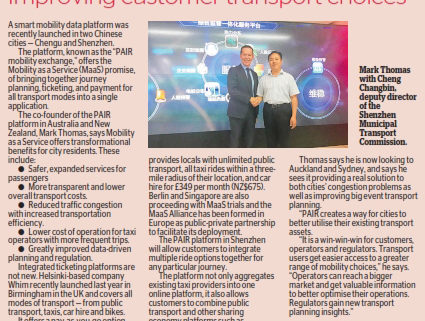China Business: Improving customer transport choices (NZ Herald)
A smart mobility data platform was recently launched in two Chinese cities — Chengu and Shenzhen.
The platform, known as the “PAIR mobility exchange,” offers the Mobility as a Service (MaaS) promise, of bringing together journey planning, ticketing, and payment for all transport modes into a single application.
The co-founder of the PAIR platform in Australia and New Zealand, Mark Thomas, says Mobility as a Service offers transformational benefits for city residents. These include:
- Safer, expanded services for passengers
- More transparent and lower overall transport costs.
- Reduced traffic congestion with increased transportation efficiency.
- Lower cost of operation for taxi operators with more frequent trips.
- Greatly improved data-driven planning and regulation.
Integrated ticketing platforms are not new. Helsinki-based company Whim recently launched last year in Birmingham in the UK and covers all modes of transport — from public transport, taxis, car hire and bikes. It offers a pay-as-you-go option, as well as an unlimited service, which provides locals with unlimited public transport, all taxi rides within a three-mile radius of their location, and car hire for £349 per month (NZ$675). Berlin and Singapore are also proceeding with MaaS trials and the MaaS Alliance has been formed in Europe as a public-private partnership to facilitate its deployment.
The PAIR platform in Shenzhen will allow customers to integrate multiple ride options together for any particular journey.
The platform not only aggregates existing taxi providers into one online platform, it also allows customers to combine public transport and other sharing economy platforms such as e-scooters to get to their destination.
Thomas says he is now looking to Auckland and Sydney, and says he sees it providing a real solution to both cities’ congestion problems as well as improving big event transport planning.
“PAIR creates a way for cities to better utilise their existing transport assets.
“It is a win-win-win for customers, operators and regulators. Transport users get easier access to a greater range of mobility choices,” he says. “Operators can reach a bigger market and get valuable information to better optimise their operations. Regulators gain new transport planning insights.”




Leave a Reply
Want to join the discussion?Feel free to contribute!